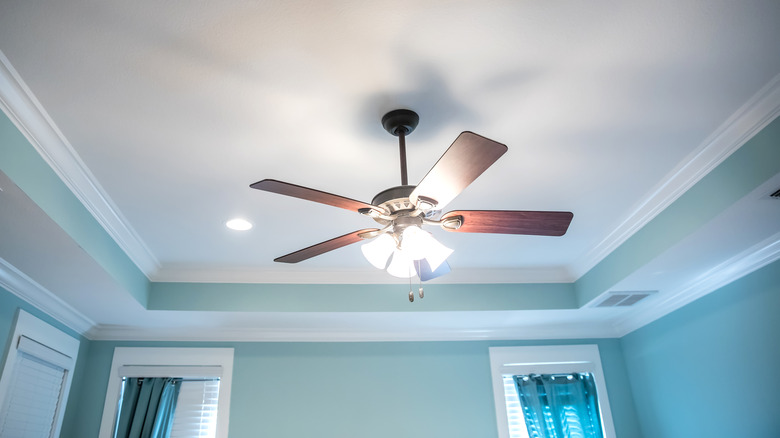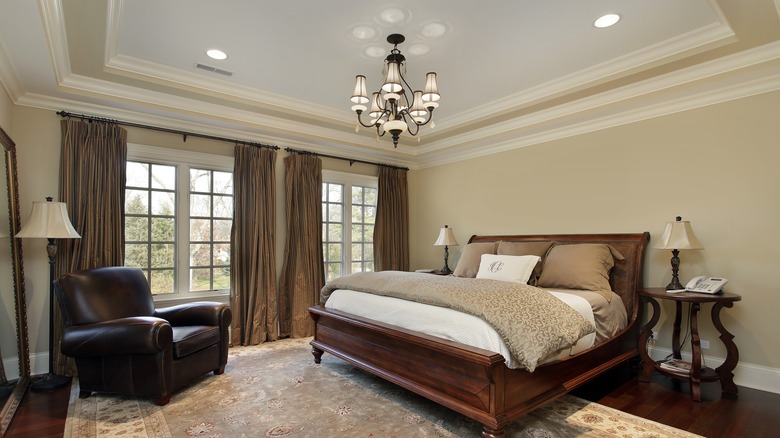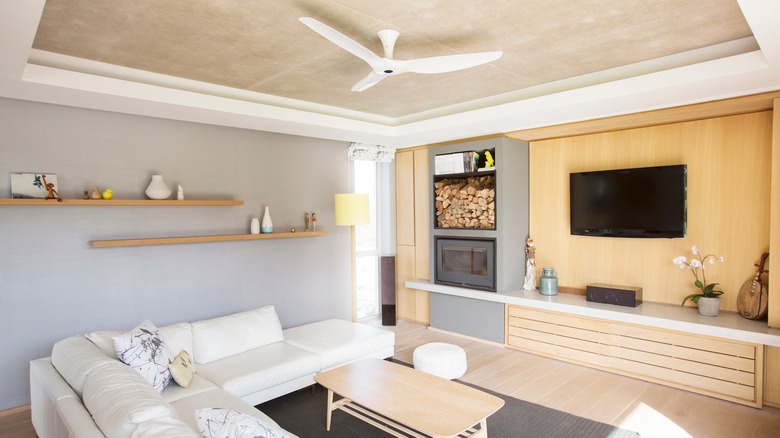Are Tray Ceilings Out Of Style?
Are tray ceilings outdated or a timeless architectural design? Ornate, recessed, and vaulted ceilings are nothing new; they've appeared in architecture since the middle ages, from Gothic cathedrals to The Plaza Hotel's Grand Ballroom (via Homedit). Tray ceilings, however, are much more simplistic in design, with the primary function of adding height and dimension to an otherwise standard room. Tray ceilings can follow the layout of the room, be polygon-shaped, have double trays, or be designed with crown molding and wainscoting. Tray ceilings are typically installed in high-end dwellings, and they saw a major trend spike in suburban homes in the 1990s and early 2000s. With that being said, many homeowners wonder if their tray ceilings may be falling out of style today.
There's good news and bad news when it comes to the trendiness of tray ceilings. Elle Decor explains that they offer a clever and classy way to hide wires and air ducts in older renovated homes. But while the concept of raised ceilings will always be timeless, tray ceilings, specifically, have the potential to date your home. This is mostly true for the deep-set, block-painted trays of the early aughts. However, with the right approach, you can ensure that your tray ceilings continue to look fresh, modern, and fashionable.
These designs date your tray ceilings
A neutral design choice in and of itself, the timelessness or trendiness of your tray ceiling has a lot to do with surrounding decor and fixtures. Shabby chic decor was a major theme of 1990s interior design, with hefty wood furniture, bulky curtains, and oiled bronze, according to Insider. In the early 2000s, this transformed into a Tuscan-inspired aesthetic, which brought in beige walls and granite countertops. If you're worried about your tray ceilings looking dated, you'll want to avoid these other dated designs at all costs, including shabby chic and Tuscan. Instead, swap out your heavy, dark pieces for more lightweight and eclectic furniture, and choose a modern, minimal light fixture or ceiling fan.
Before changing anything on your ceiling itself, make sure you know what kind of ceiling you have. Nest Casa warns that tray ceilings are easy to get confused with coffered ceilings, which have a grid-like pattern and are typically made with polished hardwood beams. Coffered ceilings can also soften the acoustics of a room, says Elle Decor, while tray ceilings are mostly decorative. If you're lucky enough to have authentic coffered ceilings in your home, don't touch them; coffered ceilings are enviable and timeless. After all, a simple change of wall paint color or light fixtures may be all you need to update your design.
How to update your tray ceilings
Minimalism and neutrals have been popular in home design for several years now, but interior designer Kendall Wilkinson recommends adding a bright color or patterned wallpaper to your tray ceiling to create more interest in the room (via Elle Decor). Another option for modernizing a tray ceiling is to bring in textural elements like wood beams, polished or painted slats, or wainscoting. If you're feeling especially inspired by your home's historic roots, Nest Casa suggests incorporating ornate crown molding, swirls, and even gold leaf. Overall, you want to include the tray ceiling in your interior design, bringing it down to meet you, rather than tucking it up and out of the way.
If you don't yet have a tray ceiling but are considering installing one, there are a few factors to consider. The existing height of your space is one of the most important aspects involved when installing this type of feature. Tell Me Best notes that the dropped-down design has the potential to make a space look and feel smaller, despite creating a raised area in the middle. If you already have tall ceilings, this shouldn't be much of a concern, but you may still want to consider a lower profile tray. A shallow design will not only save you headspace, but it also tends to look more modern than the deep-set crown-molded trays of the 1990s.


